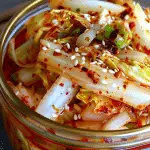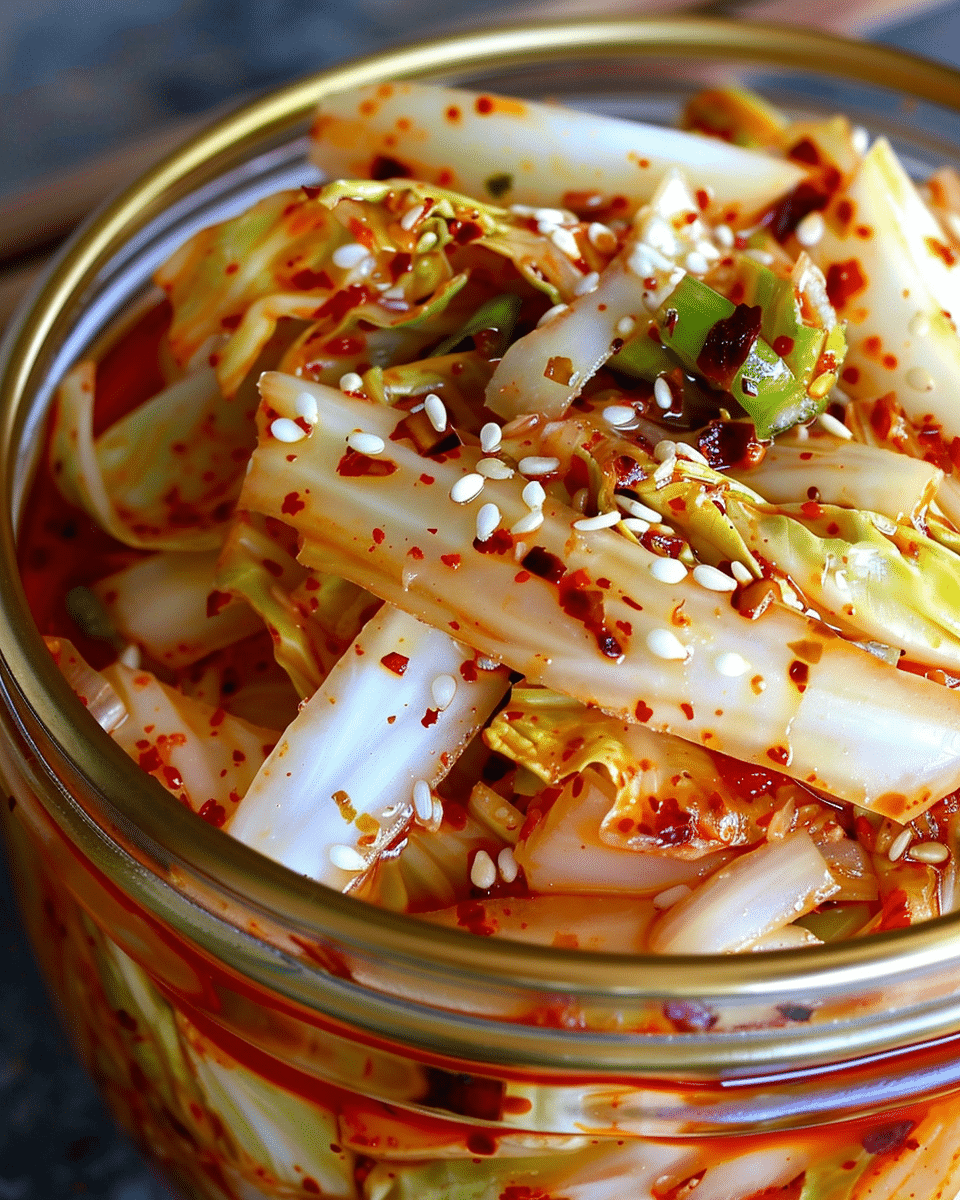Spicy Fermented Korean Cabbage, commonly known as Kimchi, is a staple in Korean cuisine, renowned for its tangy, spicy, and umami-rich flavors. This traditional fermented side dish not only adds a burst of flavor to any meal but also boasts numerous health benefits, including probiotics for gut health. In this SEO-optimized article, we’ll guide you through a simple yet authentic recipe to make your own kimchi at home.
Ingredients:
1 medium napa cabbage
1/4 cup sea salt
4 cups water
1 tablespoon grated ginger
4 cloves garlic, minced
2 tablespoons Korean red pepper flakes (gochugaru)
1 tablespoon sugar
4 green onions, chopped
1 medium carrot, julienned
1 small daikon radish, julienned (optional)
2 tablespoons fish sauce (optional)
Directions:
Prepare the Cabbage:
Cut the Cabbage: Begin by cutting the napa cabbage into bite-sized pieces. This will make it easier to handle and ensure even fermentation.
Salt the Cabbage:
Dissolve Salt: In a large bowl, dissolve 1/4 cup of sea salt in 4 cups of water.
Soak Cabbage: Add the cabbage pieces to the saltwater solution and let them soak for about 2 hours. This process helps to draw out moisture from the cabbage, ensuring a crunchy texture in the final product.
Rinse and Drain: After 2 hours, rinse the cabbage thoroughly under cold running water to remove excess salt. Drain well and set aside.
Make the Paste:
Combine Ingredients: In a mixing bowl, combine 1 tablespoon grated ginger, 4 minced garlic cloves, 2 tablespoons of Korean red pepper flakes (gochugaru), 1 tablespoon of sugar, and 2 tablespoons of fish sauce (if using). This spicy paste is the heart of your kimchi’s flavor.
Mix Vegetables:
Add Vegetables: Add the chopped green onions, julienned carrot, and julienned daikon radish (if using) to the spicy paste. Mix well to coat the vegetables evenly.
Mix with Cabbage: Incorporate the cabbage into the vegetable and spice mixture, ensuring every piece is thoroughly coated.
Ferment:
Pack the Mixture: Transfer the mixture into a clean jar. Press down firmly to remove any air bubbles, leaving about an inch of space at the top to allow for expansion during fermentation.
Fermentation Process: Cover the jar loosely and let it ferment at room temperature for 1-5 days. The fermentation time can vary based on the ambient temperature and your personal taste preference. Taste the kimchi daily and move it to the refrigerator once it reaches your desired level of fermentation.
Serving Tips:
Enjoy Fresh or Fermented: Spicy Fermented Korean Cabbage, or kimchi, can be served fresh or fermented. Fresh kimchi has a crunchy texture and vibrant flavors, while fermented kimchi develops a tangier taste over time.
As a Side Dish: Serve kimchi alongside rice, grilled meats, or as a topping for tacos and burgers. Its spicy and tangy flavors complement a wide range of dishes.
In Korean Dishes: Incorporate kimchi into traditional Korean recipes like Kimchi Fried Rice (Kimchi Bokkeumbap) or Kimchi Stew (Kimchi Jjigae) for an authentic taste.
In Wraps and Sandwiches: Use kimchi to add a zesty kick to wraps, sandwiches, or even as a topping for hot dogs and sausages.
As a Garnish: Sprinkle chopped kimchi over salads, soups, or noodle dishes to enhance their flavor and add a crunchy texture.
Storage Tips:
Refrigeration: After fermenting to your desired taste, store kimchi in the refrigerator. Keep it tightly sealed in its jar or container to preserve its flavors and prevent it from drying out.
Fermentation Time: The flavor of kimchi intensifies as it ferments. For optimal taste, refrigerate kimchi after 1-5 days of fermentation at room temperature, depending on how tangy you prefer it.
Use Clean Utensils: Always use clean utensils when removing kimchi from the jar to avoid contamination and maintain its freshness.
Longevity: Properly stored kimchi can last for several weeks to months in the refrigerator. Over time, it may continue to ferment, developing deeper flavors.
Storage Containers: Use glass jars or food-grade plastic containers with airtight lids for storing kimchi. Ensure containers are clean and dry before transferring kimchi to prevent spoilage.
Related Recipes:
FAQs:
Conclusion:
Making your own Spicy Fermented Korean Cabbage at home allows you to customize the level of spiciness and tanginess to suit your taste preferences. Whether you’re new to fermenting foods or a seasoned pro, this recipe promises a delicious journey into Korean culinary traditions. Try it today and elevate your meals with a taste of homemade kimchi!
📖 Recipe:
Print
Spicy Fermented Korean Cabbage
- Total Time: 1-5 days (including fermentation)
- Yield: Makes about 1 quart jar of kimchi
- Diet: Vegetarian
Description
Discover the authentic flavors of Spicy Fermented Korean Cabbage (Kimchi) with this easy-to-follow homemade recipe. Learn how to prepare and ferment this traditional Korean dish, perfect for enhancing meals or enjoying as a healthy snack.
Ingredients
1 medium napa cabbage
1/4 cup sea salt
4 cups water
1 tablespoon grated ginger
4 cloves garlic, minced
2 tablespoons Korean red pepper flakes (gochugaru)
1 tablespoon sugar
4 green onions, chopped
1 medium carrot, julienned
1 small daikon radish, julienned (optional)
2 tablespoons fish sauce (optional)
Instructions
- Prepare the cabbage by cutting it into bite-sized pieces.
- Dissolve sea salt in water and soak cabbage for 2 hours. Rinse and drain.
- Make a paste with ginger, garlic, red pepper flakes, sugar, and fish sauce (if using).
- Mix in green onions, carrot, and daikon radish with the paste.
- Pack the mixture into a jar, press down to remove air bubbles, leaving space at the top.
- Ferment at room temperature for 1-5 days, then refrigerate.
Notes
Adjust spice level by varying Korean red pepper flakes.
Ensure vegetables are fully submerged in brine during fermentation.
Taste periodically to achieve desired tanginess before refrigerating.
- Prep Time: 30 minutes
- Category: Side Dish, Fermented Foods
- Method: Fermentation
- Cuisine: Korean
Nutrition
- Serving Size: Makes about 1 quart jar of kimchi








